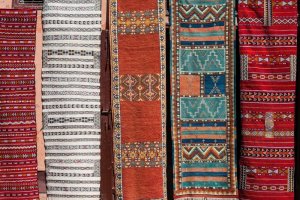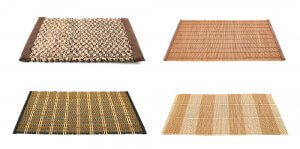Natural Fiber Rugs of Vegetable Origin

For many people, rugs are one of their favorite decorative resources. This item doesn’t only help us to define specific areas, but also provides texture and color. However, now that summer is approaching, it isn’t particularly pleasant to have something warm under your feet. To avoid this problem, the perfect solution is natural fiber rugs of vegetable origin.
They’re the latest trend in interior design. It’s more and more common to find this item in the houses of the most prestigious interior designers. This is due to its main characteristics – rough textures and earthy tones.
In addition to this, natural fiber rugs are durable, elegant, and, depending on the fiber, can also be very affordable. If you’re thinking of incorporating a natural carpet into your home, then don’t miss the rest of this article.
Where do you get your natural fiber carpet?

Natural fiber rugs are a decorative resource that has gained popularity thanks to the current trend of searching for natural products. As their name suggests, these fabrics are obtained from organic products and, within these, we can distinguish two types:
- Natural fabrics of animal origin – within this range, classic fabrics such as wool or leather stand out.
- Natural fabrics of vegetable origin – obtained from the stem or leaf of different plants. This material is also known as matting.
The materials that we can find to make this type of rug are very varied. The most popular ones are:
- Sisal is a tropical plant native to Mexico, which provides a strong and durable fiber that’s commonly used for the manufacture of rope, twine, paper, clothing, and carpets.
- Similarly, jute is a soft vegetable fiber that’s usually spun into long, strong threads.
- Bamboo rugs are one of the most successful current trends thanks to their exotic appearance. This material resists moisture very well and doesn’t need much looking after. It’s perfect for both indoor and outdoor use.
Although these are the most common, we can also find other materials, such as esparto grass, braided reed, hemp, or coconut.
Advantages of natural fiber carpets of vegetable origin

The use of this type of rug has several advantages that make them a perfect option for home decoration:
- This type of rug is much more affordable than traditional rugs, such as the Persian or Turkish ones. Besides, they don’t need a lot of looking after, and they’re very resistant, making it an excellent investment.
- They’re one of the most versatile complements we can incorporate at home, as they fit perfectly in any environment and with practically all types of furniture.
- Unlike synthetic fibers, natural fiber rugs of vegetable origin isolate the temperature very well, without giving a sensation of heat. This characteristic makes them the ideal resource in both winter and summer.
- Many suppliers of this product offer the option of making the rug to measure and even customizing it, as there are all sorts of borders and trims you can add to them.
- Also, some of these fabrics, such as sisal, are resistant to humidity. Because of this, we can use them both indoors and outdoors.
How to combine your rug

When choosing a fabric, in addition to the pattern and color, you must take into account its texture. This will determine what type of environment it’s most suitable for. In the case of natural fiber rugs of vegetable origin, we can use this resource for any type of decoration style, thanks to their great versatility.
- Natural rugs fit in very well with gentle styles, such as raw or rustic. This complement enhances the importance of natural and organic materials to achieve an excellent decorative balance.
- The simplicity of its fabrics and its neutral shades make it a suitable resource for more modern and minimalist designs too.
- Another way of incorporating your natural rug is as a carpet. In this way, it will be the main covering for the whole floor. You can combine it with other types of rugs to create some great texture combinations.
https://midecoracion.com/de-paso/alfombras-de-tejido-natural-de-origen-vegetal/
For many people, rugs are one of their favorite decorative resources. This item doesn’t only help us to define specific areas, but also provides texture and color. However, now that summer is approaching, it isn’t particularly pleasant to have something warm under your feet. To avoid this problem, the perfect solution is natural fiber rugs of vegetable origin.
They’re the latest trend in interior design. It’s more and more common to find this item in the houses of the most prestigious interior designers. This is due to its main characteristics – rough textures and earthy tones.
In addition to this, natural fiber rugs are durable, elegant, and, depending on the fiber, can also be very affordable. If you’re thinking of incorporating a natural carpet into your home, then don’t miss the rest of this article.
Where do you get your natural fiber carpet?

Natural fiber rugs are a decorative resource that has gained popularity thanks to the current trend of searching for natural products. As their name suggests, these fabrics are obtained from organic products and, within these, we can distinguish two types:
- Natural fabrics of animal origin – within this range, classic fabrics such as wool or leather stand out.
- Natural fabrics of vegetable origin – obtained from the stem or leaf of different plants. This material is also known as matting.
The materials that we can find to make this type of rug are very varied. The most popular ones are:
- Sisal is a tropical plant native to Mexico, which provides a strong and durable fiber that’s commonly used for the manufacture of rope, twine, paper, clothing, and carpets.
- Similarly, jute is a soft vegetable fiber that’s usually spun into long, strong threads.
- Bamboo rugs are one of the most successful current trends thanks to their exotic appearance. This material resists moisture very well and doesn’t need much looking after. It’s perfect for both indoor and outdoor use.
Although these are the most common, we can also find other materials, such as esparto grass, braided reed, hemp, or coconut.
Advantages of natural fiber carpets of vegetable origin

The use of this type of rug has several advantages that make them a perfect option for home decoration:
- This type of rug is much more affordable than traditional rugs, such as the Persian or Turkish ones. Besides, they don’t need a lot of looking after, and they’re very resistant, making it an excellent investment.
- They’re one of the most versatile complements we can incorporate at home, as they fit perfectly in any environment and with practically all types of furniture.
- Unlike synthetic fibers, natural fiber rugs of vegetable origin isolate the temperature very well, without giving a sensation of heat. This characteristic makes them the ideal resource in both winter and summer.
- Many suppliers of this product offer the option of making the rug to measure and even customizing it, as there are all sorts of borders and trims you can add to them.
- Also, some of these fabrics, such as sisal, are resistant to humidity. Because of this, we can use them both indoors and outdoors.
How to combine your rug

When choosing a fabric, in addition to the pattern and color, you must take into account its texture. This will determine what type of environment it’s most suitable for. In the case of natural fiber rugs of vegetable origin, we can use this resource for any type of decoration style, thanks to their great versatility.
- Natural rugs fit in very well with gentle styles, such as raw or rustic. This complement enhances the importance of natural and organic materials to achieve an excellent decorative balance.
- The simplicity of its fabrics and its neutral shades make it a suitable resource for more modern and minimalist designs too.
- Another way of incorporating your natural rug is as a carpet. In this way, it will be the main covering for the whole floor. You can combine it with other types of rugs to create some great texture combinations.
https://midecoracion.com/de-paso/alfombras-de-tejido-natural-de-origen-vegetal/
All cited sources were thoroughly reviewed by our team to ensure their quality, reliability, currency, and validity. The bibliography of this article was considered reliable and of academic or scientific accuracy.
- Gillow, J. & Sentance, B. (2000). Tejidos del mundo: guía visual de las técnicas tradicionales, Guipúzcoa: Nerea.
- Suárez, A. (2014). Decoración y ambientación en habitaciones y zonas comunes en alojamientos, España: ELEARNING.







